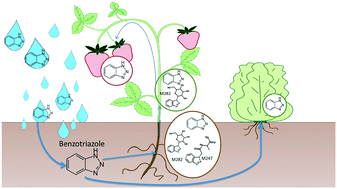Abstract
Water reuse is increasingly common for irrigation in water-stressed regions but may expose crops and thus consumers to trace contaminants. We quantified the residual of the anticorrosive compound benzotriazole (BT) and BT plant metabolites (BTM) in greenhouse and field-grown strawberry and lettuce plants; BTM were only recently discovered under laboratory conditions. In addition, we conducted laboratory proteomics experiments to determine if a BT-substituted tryptophan metabolite was incorporated into plant proteins as an alternate exposure pathway. We discovered the presence of BT residual in strawberry plants (median = 13.1 ng g−1, dry weight), which was not different (p > 0.1) between exposure conditions (BT-spiked, recycled, tap, or well water) or between the field and greenhouse grown plants. The lettuce BT residual (median = 67.8 ng g−1), however, was significantly greater than that in strawberry (p = 0.0001). The metabolites glycosylated-BT and BT-acetylalanine were present in multiple strawberry tissue samples (except fruits) but not in lettuce, indicating that differential BT metabolism occurred between plant species and components. The ubiquity of BT in the plant samples prompted testing of a limited number of relevant water sources (tap, DI, MBR effluent). Herein, we report initial discovery of BT in tap water in the US (15 ng L−1 Stanford, CA; 3.7 ng L−1 Golden, CO). Our proteomics work demonstrates that BT is not systematically incorporated into Arabidopsis plant proteins. We hypothesize that BT may instead be assimilated by plants and regulated internally, thus resulting in similar observed residual levels regardless of exposure. The results of this work suggest that BT may be more widely distributed in the environment than previously thought, including as novel transformation products.



 Please wait while we load your content...
Please wait while we load your content...